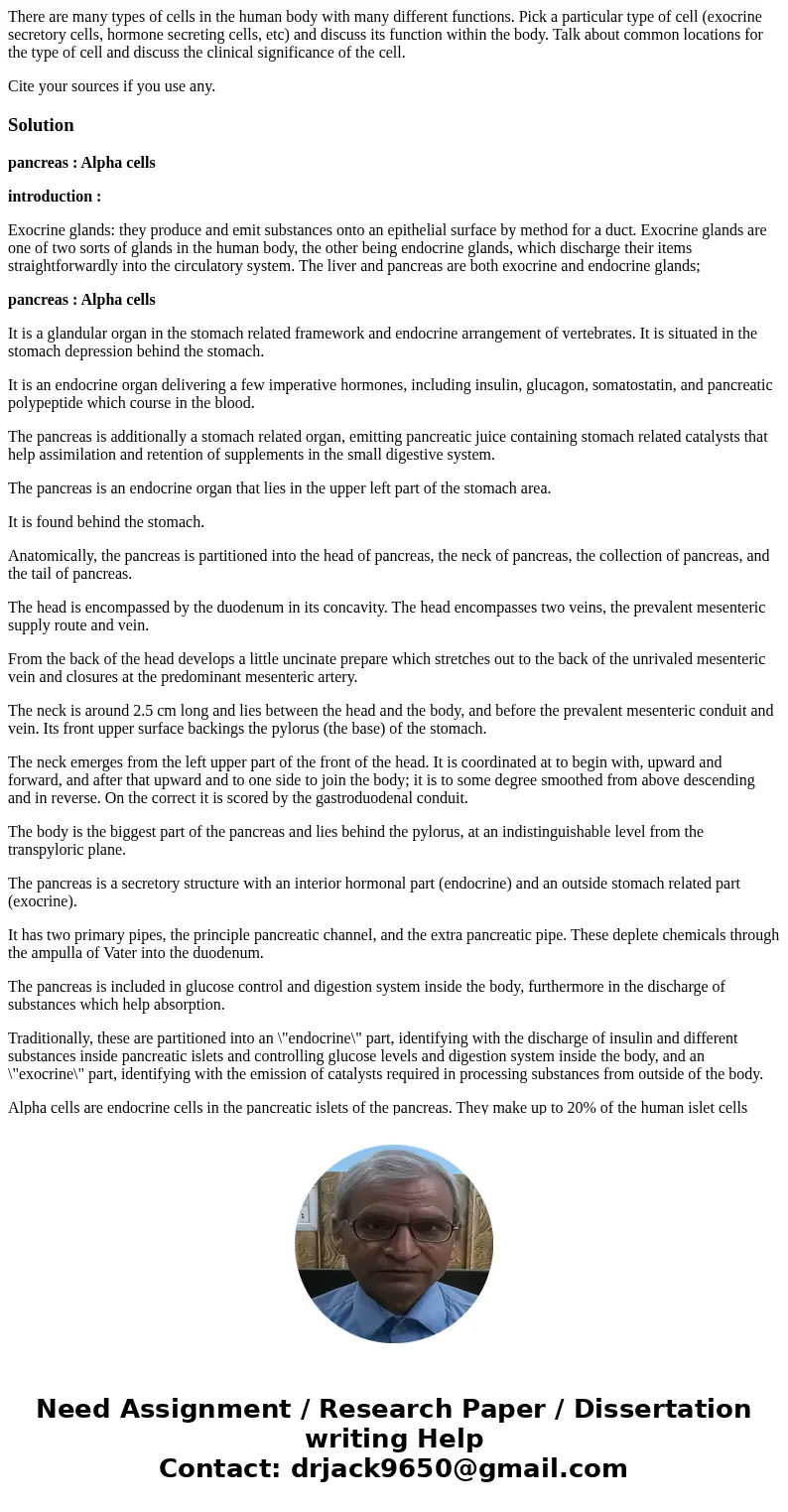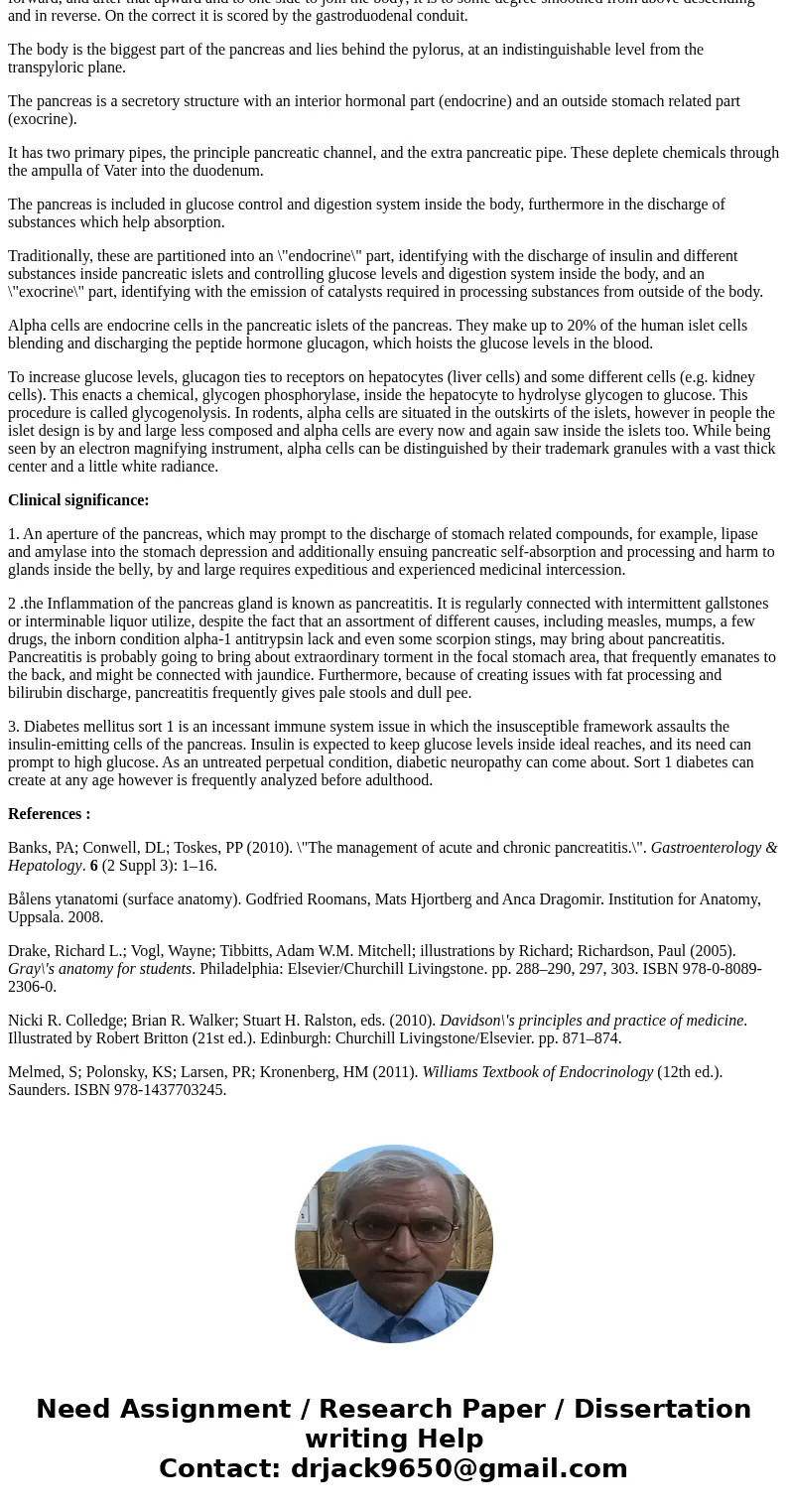There are many types of cells in the human body with many di
There are many types of cells in the human body with many different functions. Pick a particular type of cell (exocrine secretory cells, hormone secreting cells, etc) and discuss its function within the body. Talk about common locations for the type of cell and discuss the clinical significance of the cell.
Cite your sources if you use any.
Solution
pancreas : Alpha cells
introduction :
Exocrine glands: they produce and emit substances onto an epithelial surface by method for a duct. Exocrine glands are one of two sorts of glands in the human body, the other being endocrine glands, which discharge their items straightforwardly into the circulatory system. The liver and pancreas are both exocrine and endocrine glands;
pancreas : Alpha cells
It is a glandular organ in the stomach related framework and endocrine arrangement of vertebrates. It is situated in the stomach depression behind the stomach.
It is an endocrine organ delivering a few imperative hormones, including insulin, glucagon, somatostatin, and pancreatic polypeptide which course in the blood.
The pancreas is additionally a stomach related organ, emitting pancreatic juice containing stomach related catalysts that help assimilation and retention of supplements in the small digestive system.
The pancreas is an endocrine organ that lies in the upper left part of the stomach area.
It is found behind the stomach.
Anatomically, the pancreas is partitioned into the head of pancreas, the neck of pancreas, the collection of pancreas, and the tail of pancreas.
The head is encompassed by the duodenum in its concavity. The head encompasses two veins, the prevalent mesenteric supply route and vein.
From the back of the head develops a little uncinate prepare which stretches out to the back of the unrivaled mesenteric vein and closures at the predominant mesenteric artery.
The neck is around 2.5 cm long and lies between the head and the body, and before the prevalent mesenteric conduit and vein. Its front upper surface backings the pylorus (the base) of the stomach.
The neck emerges from the left upper part of the front of the head. It is coordinated at to begin with, upward and forward, and after that upward and to one side to join the body; it is to some degree smoothed from above descending and in reverse. On the correct it is scored by the gastroduodenal conduit.
The body is the biggest part of the pancreas and lies behind the pylorus, at an indistinguishable level from the transpyloric plane.
The pancreas is a secretory structure with an interior hormonal part (endocrine) and an outside stomach related part (exocrine).
It has two primary pipes, the principle pancreatic channel, and the extra pancreatic pipe. These deplete chemicals through the ampulla of Vater into the duodenum.
The pancreas is included in glucose control and digestion system inside the body, furthermore in the discharge of substances which help absorption.
Traditionally, these are partitioned into an \"endocrine\" part, identifying with the discharge of insulin and different substances inside pancreatic islets and controlling glucose levels and digestion system inside the body, and an \"exocrine\" part, identifying with the emission of catalysts required in processing substances from outside of the body.
Alpha cells are endocrine cells in the pancreatic islets of the pancreas. They make up to 20% of the human islet cells blending and discharging the peptide hormone glucagon, which hoists the glucose levels in the blood.
To increase glucose levels, glucagon ties to receptors on hepatocytes (liver cells) and some different cells (e.g. kidney cells). This enacts a chemical, glycogen phosphorylase, inside the hepatocyte to hydrolyse glycogen to glucose. This procedure is called glycogenolysis. In rodents, alpha cells are situated in the outskirts of the islets, however in people the islet design is by and large less composed and alpha cells are every now and again saw inside the islets too. While being seen by an electron magnifying instrument, alpha cells can be distinguished by their trademark granules with a vast thick center and a little white radiance.
Clinical significance:
1. An aperture of the pancreas, which may prompt to the discharge of stomach related compounds, for example, lipase and amylase into the stomach depression and additionally ensuing pancreatic self-absorption and processing and harm to glands inside the belly, by and large requires expeditious and experienced medicinal intercession.
2 .the Inflammation of the pancreas gland is known as pancreatitis. It is regularly connected with intermittent gallstones or interminable liquor utilize, despite the fact that an assortment of different causes, including measles, mumps, a few drugs, the inborn condition alpha-1 antitrypsin lack and even some scorpion stings, may bring about pancreatitis. Pancreatitis is probably going to bring about extraordinary torment in the focal stomach area, that frequently emanates to the back, and might be connected with jaundice. Furthermore, because of creating issues with fat processing and bilirubin discharge, pancreatitis frequently gives pale stools and dull pee.
3. Diabetes mellitus sort 1 is an incessant immune system issue in which the insusceptible framework assaults the insulin-emitting cells of the pancreas. Insulin is expected to keep glucose levels inside ideal reaches, and its need can prompt to high glucose. As an untreated perpetual condition, diabetic neuropathy can come about. Sort 1 diabetes can create at any age however is frequently analyzed before adulthood.
References :
Banks, PA; Conwell, DL; Toskes, PP (2010). \"The management of acute and chronic pancreatitis.\". Gastroenterology & Hepatology. 6 (2 Suppl 3): 1–16.
Bålens ytanatomi (surface anatomy). Godfried Roomans, Mats Hjortberg and Anca Dragomir. Institution for Anatomy, Uppsala. 2008.
Drake, Richard L.; Vogl, Wayne; Tibbitts, Adam W.M. Mitchell; illustrations by Richard; Richardson, Paul (2005). Gray\'s anatomy for students. Philadelphia: Elsevier/Churchill Livingstone. pp. 288–290, 297, 303. ISBN 978-0-8089-2306-0.
Nicki R. Colledge; Brian R. Walker; Stuart H. Ralston, eds. (2010). Davidson\'s principles and practice of medicine. Illustrated by Robert Britton (21st ed.). Edinburgh: Churchill Livingstone/Elsevier. pp. 871–874.
Melmed, S; Polonsky, KS; Larsen, PR; Kronenberg, HM (2011). Williams Textbook of Endocrinology (12th ed.). Saunders. ISBN 978-1437703245.


 Homework Sourse
Homework Sourse